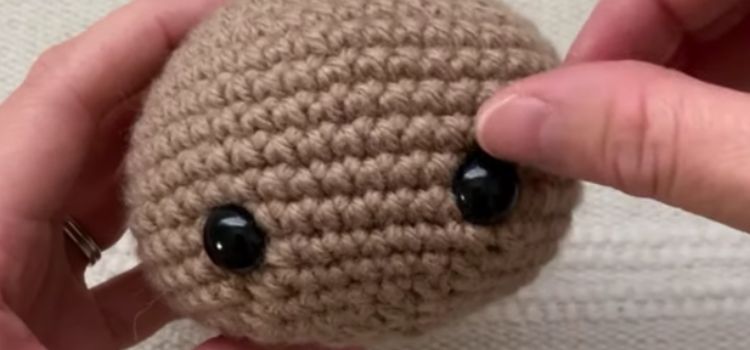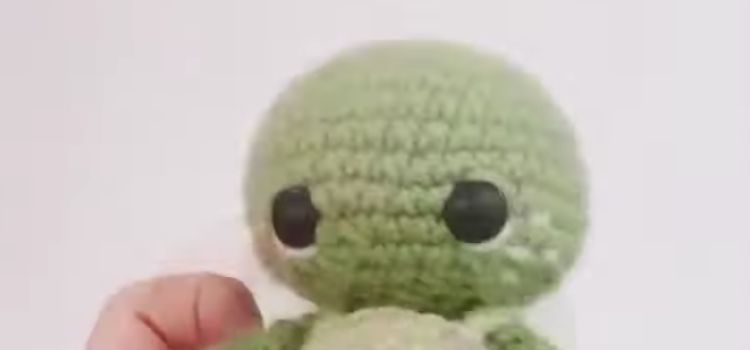As an Amazon Associate I earn from qualifying purchases.
When it comes to our children, safety is always a major consideration. As their parents, we work hard to make sure that everything we choose for them is dependable and safe. There are differing views in the discussion about safety eyes for infants. While some contend that safety eyes are completely safe, others have reservations. We will go into great detail on the subject of “Are Safety Eyes Safe for Babies” in this blog article, giving you all the knowledge you need to make an educated choice. Now let’s explore the realm of safety eyes and learn the real story behind their safety for infants.

Briefly introduce the topic of safety eyes for babies and the concerns surrounding their safety.
Safety eyes for infants is a subject that has received more and more attention in recent years. “Are safety eyes safe for babies?” is a question that a lot of caregivers and parents ask. This worry arises from the possibility of choking or harm resulting from the usage of certain safety eyes in toys, dolls, or other items intended for babies. It is therefore essential that producers and customers be aware of the safety regulations and requirements pertaining to these items. In order to protect our children’s health and safety, it is imperative that we recognize the hazards and take the appropriate safety measures.
Highlight the importance of ensuring the safety of baby products and why parents should be cautious.
It is crucial to ensure the safety of baby goods, thus parents should use care while selecting things for their infants. Babies’ health should never be compromised, thus it’s important to be informed of any possible dangers. For instance, a frequent worry among parents is whether safety eyes are suitable for infants. To make sure they adhere to safety regulations and don’t present any risks, safety eyes or similar items should be thoroughly inspected. A safe, caring atmosphere for their priceless children may be provided by parents who exercise caution and know what items are safe for babies.
Understanding Safety Eyes:
Define what safety eyes are and their purpose in baby products.
Safety eyes are an essential part of baby items that guarantee the security and welfare of newborns. The possibility of choking risks is decreased with these particularly developed eyeballs since they have a tight locking mechanism that prevents them from separating.
Babies may safely play with Safety Eyes since they are composed of premium materials without any hazardous chemicals. Safe eyes provide parents and caregivers peace of mind with their sturdy design and dependable latching method. So, are newborns safe to wear safety eyes? Of course! Little ones are protected while playing with these eyes since they are particularly designed to fulfill the highest safety requirements.
Explain the different types of safety eyes available in the market.
The market is filled with several kinds of safety eyes, all of which are intended to protect consumers. It’s crucial to think about whether safety eyes are appropriate for infants. Even while safety eyes are thought to be safe in general, it’s important to choose the appropriate kind for newborns. Plastic safety eyes are a common choice; they are lightweight and available in a range of hues and sizes. Furthermore, embroidered safety eyes reduce the possibility of tiny pieces coming loose. It is usually advised to put infant safety first by carefully choosing the right kind of safety eyes.
Safety Standards and Regulations:
Discuss the safety standards and regulations that govern baby products, including safety eyes.
In order to ensure the safety of infant items, especially safety eyes, safety standards and regulations are necessary. When it comes to our children’s safety, we should consider the question, “Are safety eyes safe for babies?” In order to protect infants and young children, these regulations set standards and requirements for the design, manufacture, and testing of baby products.
Safety eyes, which are intended to be safely fastened to toys and other infant products, are put through a thorough testing process to make sure newborns can’t choke on them or suffer any other injury. Manufacturers may provide parents peace of mind by following these safety guidelines and standards, knowing that the baby products—including those with safety eyes—that they buy are safe for their priceless young ones.
Explain the certifications and testing procedures that manufacturers need to adhere to.
To guarantee the safety of their goods, manufacturers are required to adhere to certain certifications and testing protocols. This is particularly important for devices meant for infants, like safety eyes. To ensure that the items fulfill stringent safety requirements and do not endanger newborns, these certifications and testing protocols are in place.
Manufacturers must follow regulations such as the Consumer Product Safety Improvement Act (CPSIA) and go through stringent testing processes, which may include chemical, mechanical, and flammability testing, as well as testing for choking hazards and other hazards. These precautions provide parents and other caregivers peace of mind and guarantee the safety of safety eyes and other infant items.
Potential Risks Associated with Safety Eyes:
Identify and explain the potential risks associated with safety eyes in baby products.
Safety eyes are a common option for infant items because of their eye-catching design and robust nature. Nonetheless, it’s critical to recognize and comprehend any possible concerns related to utilizing safety eyes in these items. The risk of choking risks arises if the infant ingests the eyeballs after they come loose. If the eyeballs contain protrusions or sharp edges that might hurt the baby’s sensitive skin or eyes, there’s also a chance of damage. Parents and other caregivers must, therefore, take great care to check and choose infant goods with safety eyes that adhere to industry standards and have undergone extensive safety testing.
Discuss the choking hazard and other safety concerns that parents should be aware of.
Ensuring the safety and well-being of babies requires parents to talk about the choking threat and other safety issues. Is it safe for newborns to wear safety eyes? This is a frequently asked question. Many times, parents question whether their child may choke on these kinds of eyeballs. Parents should exercise caution and make well-informed choices when choosing toys or other things for their children. Lowering the chance of choking accidents requires making sure the eyes are firmly fixed and difficult to remove. To avoid any mistakes or accidents, parents should also constantly observe their infants during playing and adhere to age standards.
Factors to Consider:
Provide a list of factors that parents should consider when evaluating the safety of safety eyes for their babies.
There are various variables that parents should take into account while assessing the safety of safety eyes for their infants. First and foremost, it’s crucial to check that the safety eyes are created especially for infants and adhere to all safety regulations. To avoid any choking dangers, parents should also check for safety eyes that are firmly fastened to the baby’s belongings, such as toys or clothing.
Parents should also look for any little pieces or loose components that the infant might swallow. Additionally, it is essential to select safety eyes that are constructed from non-toxic materials and have passed safety tests. Parents can make sure that the safety eyes they select are secure for their infants by taking these elements into account.
Discuss the importance of choosing age-appropriate products and materials.
When thinking about children’s safety and well-being, it is crucial to choose goods and materials that are appropriate for their age. Caretakers and parents must exercise caution when choosing items for children based on their age and developmental stage. For instance, employing safety eyes intended exclusively for newborns when handling toys can provide parents peace of mind. To reduce any potential choking risks, these eyes are designed with the required safety measures. A child’s safety is promoted as well as their overall growth and development when age-appropriate products and materials are used. So, are babies safe to wear safety eyes? Yes, provided that they are created expressly for that age group.
Safe Alternatives:
Present alternative options to safety eyes that parents can consider for their baby products.
Parents can question the safety of safety eyes for their young children. Thankfully, there are alternatives to traditional baby goods that guarantee the security and well-being of young children. Parents should think about using embroidered or sewn-on eyes instead of safety eyes to reduce the possibility of any pieces falling free and posing a choking hazard. Furthermore, selecting baby goods with printed eyes or characteristics might also be a secure option. By looking into these alternatives, parents can relax knowing that the things they choose for their children are safe and lovely.
Highlight safer alternatives that still provide aesthetic appeal.
When it comes to safeguarding the safety of babies, emphasizing safer alternatives that still have aesthetic appeal is an important consideration. “Are safety eyes safe for babies?” is a frequent question raised by parents. The welfare of our young children must be given top priority. It is advised to look at alternative options that are both aesthetically pleasing and secure for infants. Parents can build a nurturing environment that offers peace of mind without sacrificing the aesthetic by taking into account substitute materials or designs that remove potential risks.

Tips for Ensuring Safety:
Provide practical tips and guidelines for parents to ensure the safety of baby products with safety eyes.
Parents need to be proactive and knowledgeable when it comes to guaranteeing the safety of infant items with safety eyes. Is it safe for newborns to wear safety eyes? This is a typical question. Yes, safety eyes are safe for babies if certain safety measures are followed. Here are a few useful pointers and directives to remember. Always start by reading the instructions and suggestions provided by the manufacturer for the particular infant product.
Secondly, confirm that there are no loose pieces and that the safety eyes are firmly fixed on the product. Third, make sure the infant product is routinely inspected for wear and tear or damage, particularly in the vicinity of the safety eyes region. Lastly, watch your child make sure they are utilizing safety-eyes goods responsibly while they play with them. Parents may provide their children with a fun and safe experience by implementing these suggestions.
Include recommendations for proper maintenance and regular inspections.
In order to guarantee babies’ safety while utilizing safety eyes, proper maintenance and regular checks are essential. It’s critical to adhere to the manufacturer’s recommended maintenance schedule, which may involve routine cleaning and inspection for wear or damage. Regular inspections by a licensed expert may also assist in locating any possible problems or flaws that might endanger babies. When parents follow these guidelines, they may use safety eyes with confidence, knowing that their children are safe.
Conclusion
In conclusion, when used properly and under adult supervision, safety eyes might be a good option for babies. These eyes are particularly manufactured for use in baby toys and accessories and are meant to exceed safety regulations. But it’s imperative that you always go by the instructions provided by the manufacturer and make sure the eyes are firmly fixed on the object. It’s also essential to regularly check the toys for any broken or loose pieces in order to avoid any possible risks. When determining if safety eyes are acceptable for your infant, proceed with care and use your best judgment, just as you would with any baby product.
Amazon and the Amazon logo are trademarks of Amazon.com, Inc, or its affiliates.